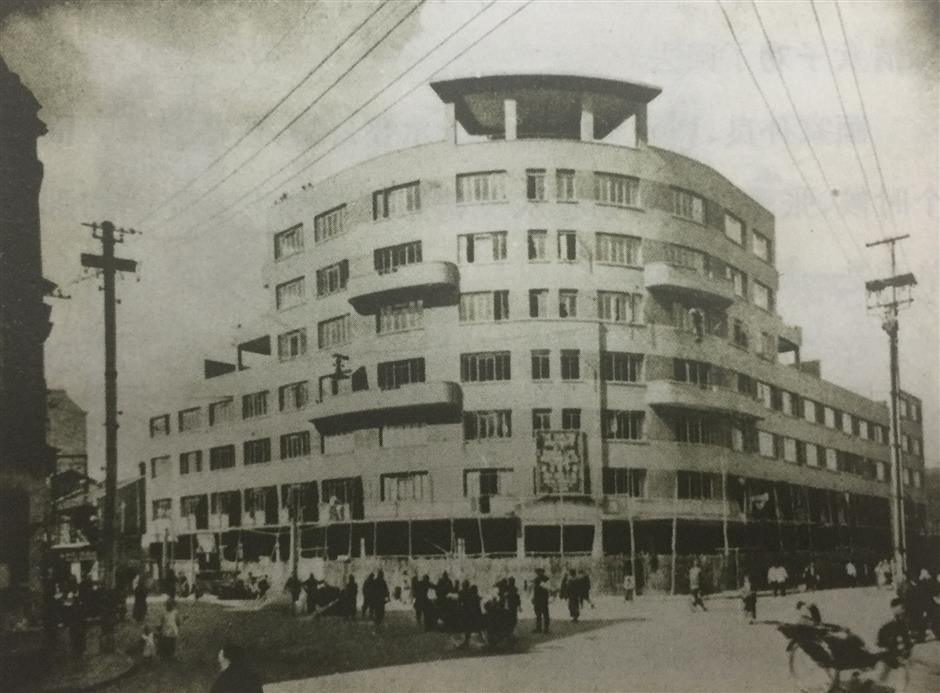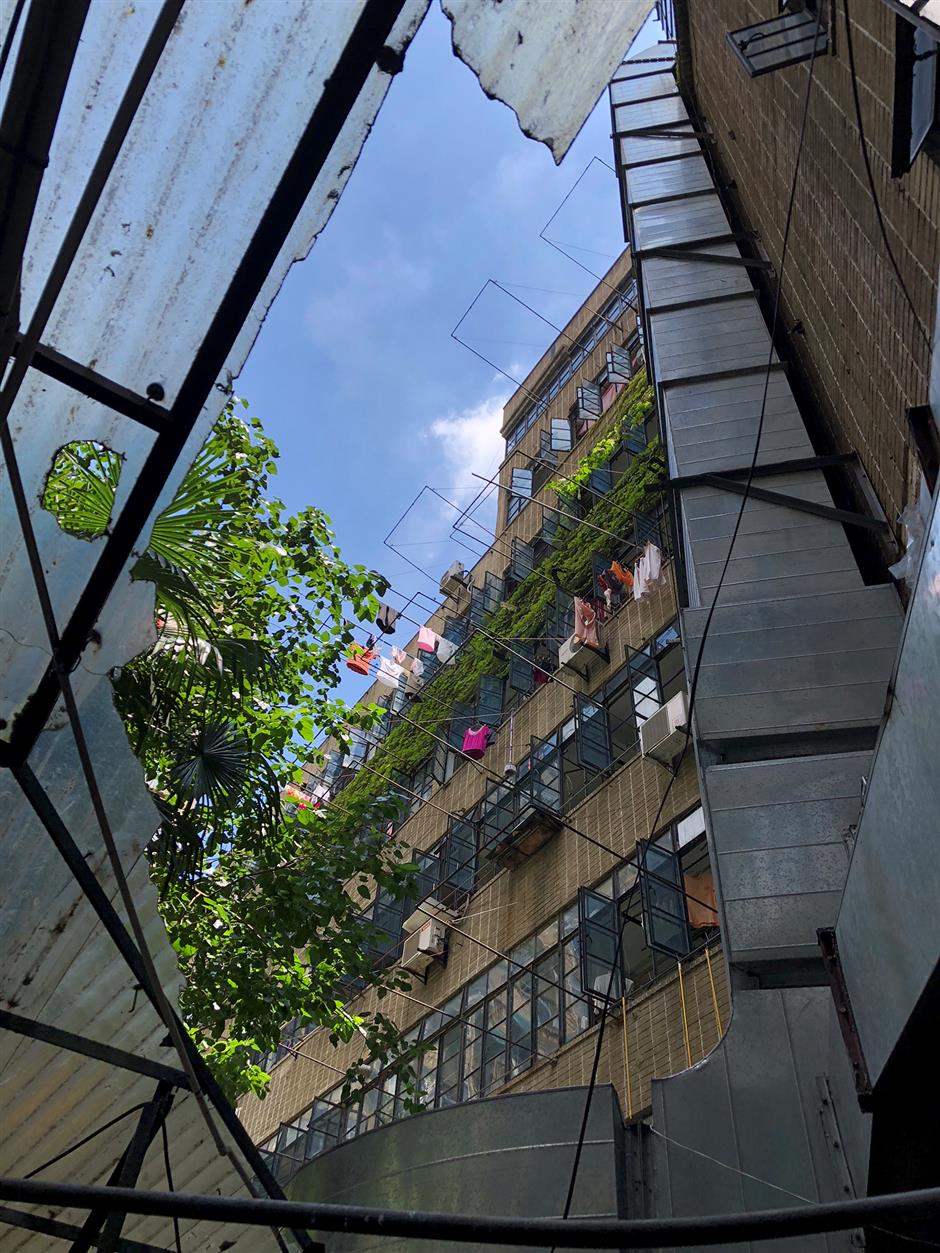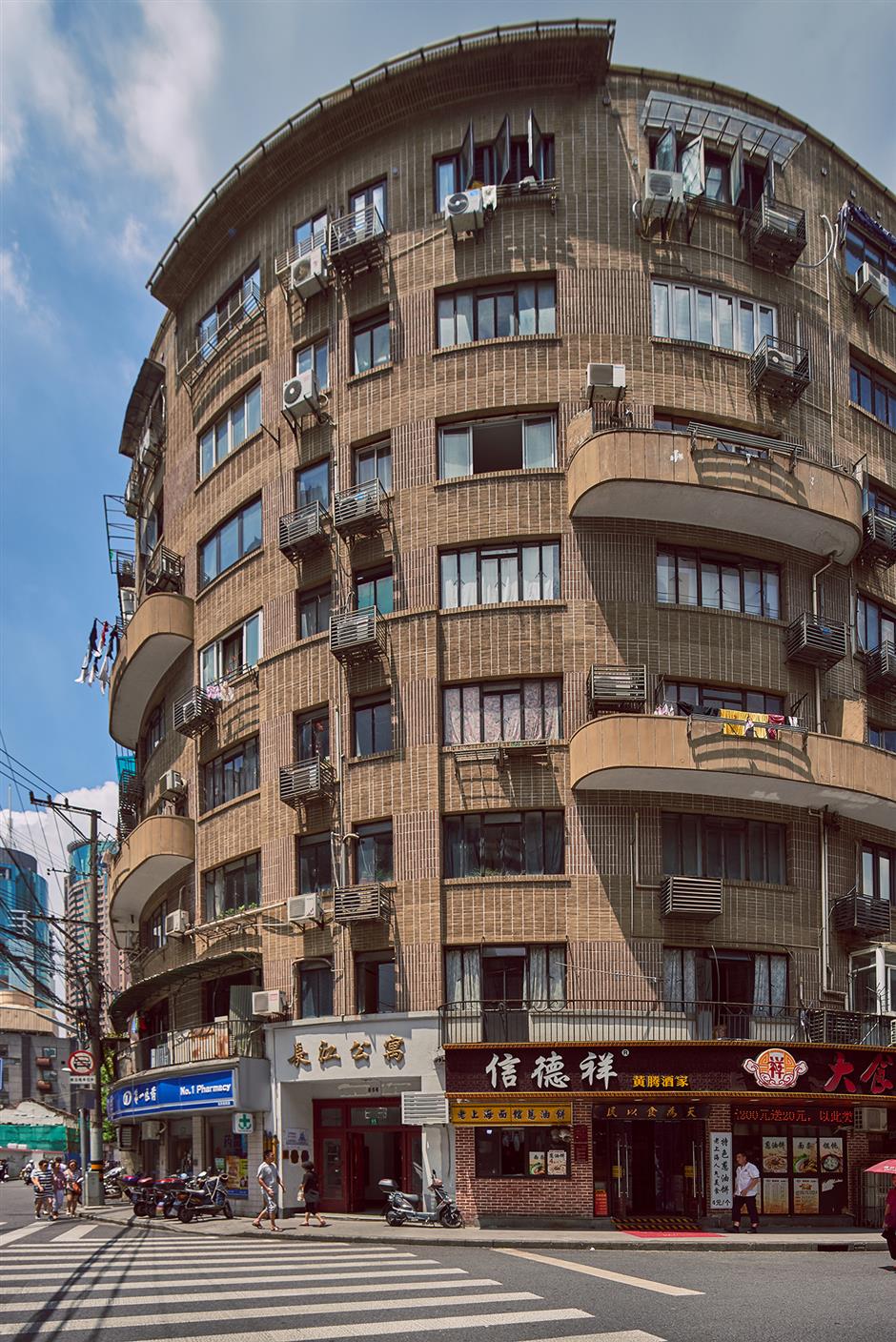Apartment block a writer's haven and home to a murder mystery
Changjiang Apartments sits on a prominent location behind the Park Hotel at People’s Square. Built during the golden era (1920s-40s) of modern Shanghai apartment buildings, it’s known as the last Shanghai home of famous author Eileen Chang.
“Changjiang Apartments, formerly called Carlton Apartments, was one of the many tall apartments which upgraded the city’s residential life,” says Tongji University professor Qian Zonghao, an expert in Shanghai’s architectural history.

A recent photo of Changjiang Apartments located at 65 Huanghe Rd.
According to his research, the city’s early residential buildings were mostly shikumen, or stone-gate houses which were built after refugees from neighboring provinces flooded into the foreign settlement of Shanghai following the Small Sword Uprising in the 1850s. New-style three-story “lane apartments” emerged in the 1920s. Every flat in a lane apartment was en suite, equipped with a kitchen, a toilet, steel-framed windows and waxed wooden floors.
“As Shanghai’s land price continued to soar since the 1920s, taller apartment buildings up to six to nine floors were built. Though every flat in taller buildings was smaller than before, living quality of flat dwellers improved due to modern design and facilities. Tall apartment buildings were in either art deco or modern style,” Qian says.
Built in 1935, the Carlton Apartments was designed in such a simple-cut way that there are only several long, curved balconies gracing the facade. The ground floor features shops and the floors above are residential. The flank is painted in a warm chocolate tone, chic and modern.

A file photo of the former Carlton Apartments taken in the 1930s.
According to a 1929 report in The China Press, the project for constructing Carlton Apartments was part of a large property transaction. Known as the “Carlton Property” situated at the corner of Bubbling Well Road (today’s Nanjing Road W) and Park Road (today’s Huanghe Road) facing the former race course, the site included buildings such as the old Grand Theater, the Carlton Theater, the late Palais de Danse, premises occupied by Arts and Crafts, shops and houses. The initial plan for the now eight-floor Carlton Apartments was taller, up to 10 to 12 floors.
According to the book “Old Shanghai Classic Apartments,” Shanghai’s apartment buildings were mostly located in commercial areas in the former international settlement or former French concession, which became signature buildings of the area such as Ruijin Building, Wukang Building and Huaihai Building.
Early apartment buildings were in classic or renaissance style, whose facades were embellished with architraves and carved brick decorations. Most apartment buildings changed toward the more modern style and simple-cut form since the late 1920s. In the 1930s taller apartment buildings such as the Carlton Apartments were prevailing in Shanghai.
A report in The China Press in 1931 also notes that “Shanghai has finally rapidly become a city of apartment houses.”
“The construction of apartment buildings in Shanghai started from the 1920s and continued until the 1940s. After 1949 the government built many residential compounds for local workers, the style of which were on the base of old Shanghai apartment buildings but was added with characteristic of similar residential compounds in the former Soviet Union,” Qian says.

Built in a simple-cut way in 1935, the building has apartments on one side, a public corridor and large glass windows on the other side.
Busy urban scenes
After divorcing her husband Hu Lancheng, Eileen Chang moved into the Carlton Apartments from Eddington House (today’s Changde Apartments) near the western end of Nanjing Road in 1950. Chun Zi, a Shanghai author who has written a series of books on Eileen Chang’s Shanghai footprints, finds Chang had favored apartment life and was good at choosing homes.
“The former Shanghai Race Course and the famous shopping streets — Nanjing Road and Fuzhou Road — were all within five minutes’ walk away from the Carlton Apartments. I guess the busy urban scenes had inspired Chang during her city walks from the new home,” she says.
In Flat 301 of Carlton Apartments, which Chang shared with her aunt, Chang completed several novels and movie scripts including “Eighteen Springs,” which she revised to a well-known novel “Affair of Half a Lifetime” in the US in the late 1970s and early 1980s. The novel was later adapted to a popular movie and TV series.
“Many years later, Chang’s memories of life in the Carlton Apartments were about food aroma,” she adds. “She wrote about the nice smells of bread fresh from oven of Kiessling Cafe in early mornings, which was moved from Tianjin during World War II,” Chun Zi says.
Eileen Chang left the Carlton Apartments in 1952 for Hong Kong and later the US. She never returned to the city but Shanghai was forever a theme in her writings.
“I find Shanghai and Eileen Chang are just like London and Charles Dickens, Dublin and James Joyce, Paris and Honore de Balzac and Marcel Proust. She is like coordinate and name card of Shanghai urban culture,” she says.

Flat 301 of Carlton Apartments which Eileen Chang shared with her aunt and where she completed several novels and movie scripts including “Eighteen Springs”
Before Chang moved in, the Carlton Apartments were home to many expatriate merchants. A news report of a murder in the North-China Herald on March 5, 1941 painted a picture of living in the Carlton Apartments.
According to the report, Wang Wei-chuan, Chinese servant of Mr B. P. Ghatlia, was hacked to death and he himself was attacked by two men believed to be Japanese, at the Carlton Apartments at the corner of Park and Burkill roads (today’s Huanghe and Fengyang roads) on the morning of March 4.
The report said: “According to investigations conducted by detectives of the Sinza Police Station, the two Orientals entered the victim’s flat No. 125 of the Carlton Apartments at about 7:30am yesterday and confronted him. One of the intruders pulled out a dagger and lunged at Mr Ghatlia who attempted to defend himself as best as he could.
The other assailant, however, also attacked the victim. The latter managed to fight them off and seeing no chance of escape but the open window, ran toward it and jumped out. The fall was from the first floor and a crowd gathered around the slightly injured Indian. Some persons, on learning of the occurrence, ran up and entered his flat. There they forced the door of the dining room open and saw an unpleasant sight. In the middle of the room lay the Chinese servant, apparently dead. His head had been hit in several places.”
The police found the servant had died several hours before the attack on his master. Further investigations disclosed that Ghatlia was out the previous night and did not return until late. When he came home, he did not see his boy and went to bed. In the morning, he was awakened by the intruders who attacked him.
The report did not give motives or identities of the attackers, but said Ghatlia was the manager of M. Bhaichand, an import and export firm occupying room 162 in Hamilton House, which still sits on the corner of Fuzhou and Jiangxi roads. He was progressing favorably at the General Hospital. Jumping from the window of his flat, Ghatlia sustained slight injuries to his legs.
More than half a century has passed since that news report. Today, the Hamilton House where Ghatlia had worked, the Sinza Police Station which sent detectives to investigate the murder case, the General Hospital where Ghatlia were treated, and the Carlton Apartments where Eileen Chang enjoyed the aroma of the bread fresh from the oven of Kiessling Cafe — all survive to be heritage buildings and sites in Shanghai.

The Carlton Apartments were home to many expatriate merchants.
Building Info
Yesterday: Carlton Apartments
Today: Changjiang Apartments
Architect: Elliott Hazzard
Address: 65 Huanghe Road
Year of built: 1935
Tips: The building conceals a quiet, nice yard inside.
Nowhere in the world that had more comfortable apartments
There are only two cities in the world where there has been an equal change in the building situated compared to Shanghai — namely Los Angeles and Detroit. In neither of those cities, however, has there been such a reversal of local architectural styles as there has been here on the banks of the Whangpoo.
For half a century previous to 1920 the standardized form of dwelling house was a blue and grey brick structure. A door through which more than one family would enter their homes was indeed a rarity. Steam heat, modern flush toilets and apartment houses all came in about the same time, and curiously enough the British population, which in its own country is so thoroughly wedded to the old-fashioned fireplace, where you toast the front half of your body and freeze the rear part, has been the most insistent of all nationalities in Shanghai in demanding steam heat.
The British have also vied with Americans in preferring the apartment style of living to the old-fashioned high-ceilinged house with many rooms, but mostly was built in Shanghai, the skyline has been entirely changed. Nowhere in the world are more comfortable and up-to-date apartment houses to be found than here in Shanghai.
— Excerpt from The China Weekly Review September 14, 1935

The photo, taken in the early 1920s, shows the first apartment building in Shanghai, built by officials of the Dollar Co at the corner of Avenue Joffre and Roi de Albert (today’s Huaihai Rd M and Shaanxi Rd S).
















